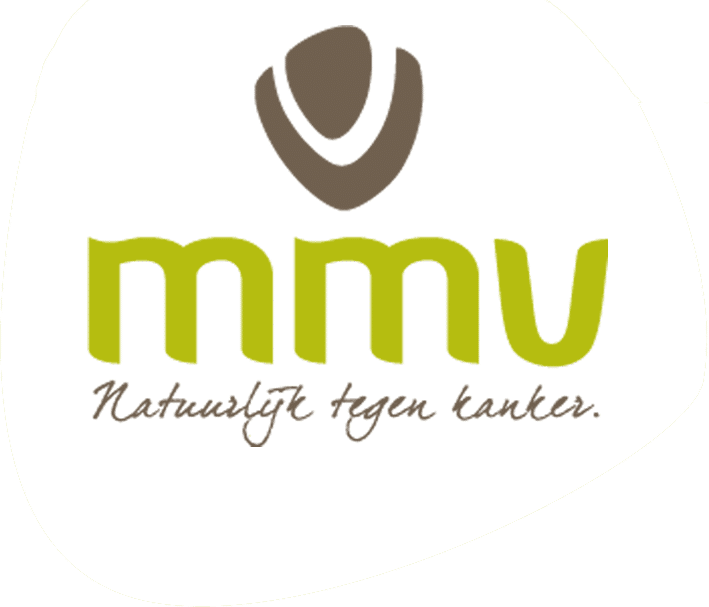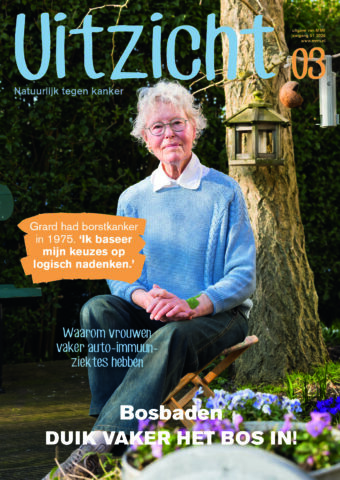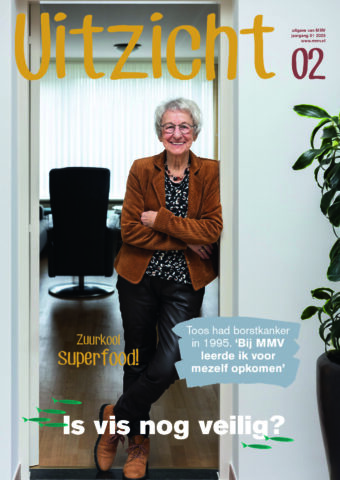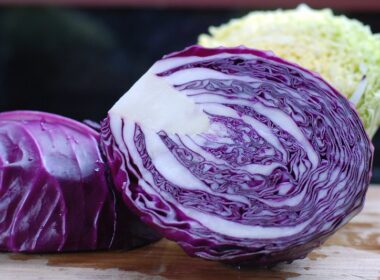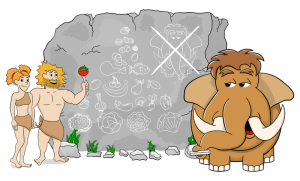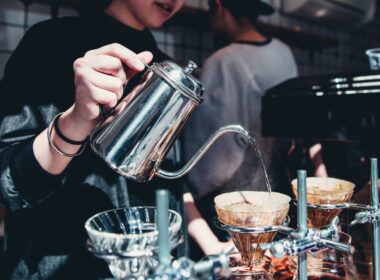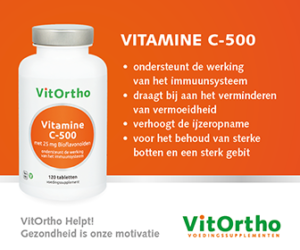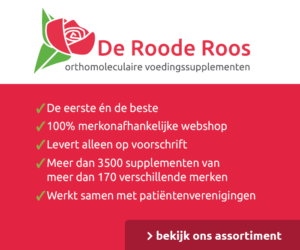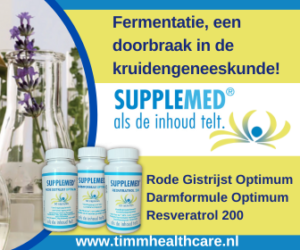‘Volwassenen krijgen dagelijks voldoende jodium binnen’, kopte het RIVM begin juli naar aanleiding van een nieuw rapport. Een eigenaardige conclusie. Bij mannen is de jodiumstatus op orde, maar vrouwen neigen naar een zorgelijk tekort.

‘Nederlandse vrouwen krijgen net genoeg jodium binnen’, luidt één conclusie uit het rapport ‘Jodiuminname van volwassenen in Noord-Nederland in 2020-2021 en trend sinds 2006-2007’ (1). De helft van de onderzochte 144 vrouwen (25-50 jaar) had een geschatte jodiuminname hoger dan 159 µg per dag. Dat is ‘goed’, concludeert het RIVM, omdat ‘de kans op gezondheidsproblemen klein is als de helft van de bevolking meer dan 150 µg per dag binnenkrijgt’. Het individu doet er kennelijk niet toe.
Naar schatting uit hetzelfde rapport neemt maximaal 2 tot 7 procent van de vrouwen (18 tot 40 jaar) constant minder dan de gemiddelde behoefte aan jodium in. Een tekort kan leiden tot gezondheidsklachten zoals een traag werkende schildklier (1). Zorgelijk, zeker bij vrouwen die, zoals in dit onderzoek, in de vruchtbare leeftijd zijn. Zelfs een mild jodiumtekort kan de neurologische ontwikkeling van het kind schaden (31,32,33,34). In een studie met hoogopgeleide zwangere Nederlandse vrouwen bevond 83 procent zich na twintig weken zwangerschap onder de jodiumgrens van de WHO (2). De WHO beschouwt ‘jodiumtekort als ’s werelds meest voorkomende, maar gemakkelijk te voorkomen oorzaak van hersenbeschadiging’. ‘Ziektes door jodiumtekort vormen een ernstige bedreiging voor de geestelijke gezondheid van kinderen en vaak zelfs voor hun overleving’ (35).
In de cijfers die de volksgezondheid moeten dienen, lijkt het te gaan om ‘vrouwen als groep’ en gaan individuen verloren. Die maximaal 7 procent vrouwen wordt blijkbaar ‘opgeofferd’ ten gunste van de gemiddelde vrouw. Trek die redenering eens door naar een laboratorium van een ziekenhuis. Je voegt alle urines van de dag bij elkaar, bepaalt het creatinine gehalte en concludeert dat de groep een goede nierfunctie heeft: iedereen mag naar huis.
De oorzaak van de slechte jodiumstatus ligt in een wettelijk besluit uit 2008. Toen is het jodiumgehalte in bakkerszout verlaagd. Prompt daalde de jodiuminname met zo’n 33 procent (1). Zestig procent van onze jodium halen we uit de jodium die aan voeding is toegevoegd (4). Producten uit de zee zijn de verreweg rijkste natuurlijke jodiumbron (6,7), maar daar eten we veel te weinig van (8,9). De Gezondheidsraad halveerde in 2015 de tot dan geldende aanbeveling voor vis (10). Zelfs die zuinige norm halen we niet (8,9). Zuivelproducten zijn na brood (met gejodeerd zout) onze tweede belangrijkste jodiumbron (1,4). Puur natuur? Alweer niet. Vooral door toevoeging aan het veevoer en het ontsmetten van de tepels met jodium (1,11).
Een tekortkoming in het RIVM-rapport is dat selenium niet wordt genoemd. Jodium en selenium werken samen (12-22) en vormen ook een duo in voeding uit de zee (6,23-28). Helaas is het met de seleniuminname in Nederland eveneens slecht gesteld: de gemiddelde dagelijkse inname van volwassenen is 50 µg (36), de is norm 70 µg (37) en seleniumexperts noemen 105 µg als optimum (38,39).
In plaats van ‘het kan nog net’ kan het RIVM beter adviseren de besluiten rondom bakkerszout en vis terug te draaien en een campagne starten voor het eten van meer vis, schelpdieren en zeewier. Goed voor onze jodium- en seleniumstatus, onze schildklier en het voorkomen van kanker.
https://www.rivm.nl/bibliotheek/rapporten/2022-0066.pdf
2. Stoutjesdijk E, Schaafsma A, Dijck-Brouwer DAJ, Muskiet FAJ. Iodine status during pregnancy and lactation: a pilot study in the Netherlands. Neth J Med. 2018 Jul;76(5):210-217. PMID: 30019676.
https://pubmed.ncbi.nlm.nih.gov/30019676/
3. Jodium in Zwangere vrouwen Onderzoek (JOZO), accessed 26 july 2022
https://www.rivm.nl/voedselconsumptiepeiling/voedingsstatusonderzoek/JOZO
4. Verkaik-Kloosterman J, Buurma-Rethan EJM, Dekkers ALM. Inzicht in de jodiuminname van kinderen en volwassenen in Nederland Resultaten uit de Voedselconsumptiepeiling 2007-2010 RIVM rapport 350090012/2012
https://www.rivm.nl/bibliotheek/rapporten/350090012.pdf
5. Fuge R. Soils and Iodine Deficiency. In: O. Selinus et al. (eds.), Essentials of Medical Geology: Revised Edition, DOI 10.1007/978-94-007-4375-5_17, # Springer Science+Business Media Dordrecht 2013
6. Öhrvik V, von Malmborg A, Mattisson I, Wretling S, Åstrand C. Fish, shellfish and fish products – analysis of nutrients. NATIONAL FOOD AGENCY, Sweden. The National Food Agency Report Series no 1/2012
7. Sorrenti S, Baldini E, Pironi D, Lauro A, D’Orazi V, Tartaglia F, Tripodi D, Lori E, Gagliardi F, Praticò M, Illuminati G, D’Andrea V, Palumbo P, Ulisse S. Iodine: Its Role in Thyroid Hormone Biosynthesis and Beyond. Nutrients. 2021 Dec 14;13(12):4469. doi: 10.3390/nu13124469. PMID: 34960019; PMCID: PMC8709459.
https://pubmed.ncbi.nlm.nih.gov/34960019/
8. C.T.M. van Rossum et al. The diet of the Dutch. Results of the Dutch National Food Consumption Survey 2012-2016. National Institute for Public Health and the Environment, RIVM. RIVM report 2020-0083
https://www.rivm.nl/bibliotheek/rapporten/2020-0083.pdf
9. RIVM. Inname onverzadigde vetzuren. Accessed 23 May 2022
https://www.wateetnederland.nl/resultaten/energie-en-macronutrienten/inname/onverzadigde%20vetzuren
10. Gezondheidsraad. Richtlijnen goede voeding 2015. Den Haag: Gezondheidsraad, 2015; publicatienr. 2015/24.
https://www.gezondheidsraad.nl/documenten/adviezen/2015/11/04/richtlijnen-goede-voeding-2015
11. van der Reijden OL, Zimmermann MB, Galetti V. Iodine in dairy milk: Sources, concentrations and importance to human health. Best Pract Res Clin Endocrinol Metab. 2017 Aug;31(4):385-395. doi: 10.1016/j.beem.2017.10.004. Epub 2017 Oct 20. PMID: 29221567.
https://pubmed.ncbi.nlm.nih.gov/29221567/
12. Arthur JR, Beckett GJ, Mitchell JH. The interactions between selenium and iodine deficiencies in man and animals. Nutr Res Rev. 1999 Jun;12(1):55-73. doi: 10.1079/095442299108728910. PMID: 19087446.
https://pubmed.ncbi.nlm.nih.gov/19087446/
13. Köhrle J. The trace element selenium and the thyroid gland. Biochimie. 1999 May;81(5):527-33. doi: 10.1016/s0300-9084(99)80105-9. PMID: 10403185.
https://pubmed.ncbi.nlm.nih.gov/10403185/
14. Zimmermann MB, Köhrle J. The impact of iron and selenium deficiencies on iodine and thyroid metabolism: biochemistry and relevance to public health. Thyroid. 2002 Oct;12(10):867-78. doi: 10.1089/105072502761016494. PMID: 12487769.
https://pubmed.ncbi.nlm.nih.gov/12487769/
15. Contempré B, de Escobar GM, Denef JF, Dumont JE, Many MC. Thiocyanate induces cell necrosis and fibrosis in selenium- and iodine-deficient rat thyroids: a potential experimental model for myxedematous endemic cretinism in central Africa. Endocrinology. 2004 Feb;145(2):994-1002. doi: 10.1210/en.2003-0886. Epub 2003 Sep 18. PMID: 14500569.
https://pubmed.ncbi.nlm.nih.gov/14500569/
16. Schomburg L, Köhrle J. On the importance of selenium and iodine metabolism for thyroid hormone biosynthesis and human health. Mol Nutr Food Res. 2008 Nov;52(11):1235-46. doi: 10.1002/mnfr.200700465. PMID: 18686295.
https://pubmed.ncbi.nlm.nih.gov/18686295/
17. Triggiani V, Tafaro E, Giagulli VA, Sabbà C, Resta F, Licchelli B, Guastamacchia E. Role of iodine, selenium and other micronutrients in thyroid function and disorders. Endocr Metab Immune Disord Drug Targets. 2009 Sep;9(3):277-94. doi: 10.2174/187153009789044392. Epub 2009 Sep 1. PMID: 19594417.
https://pubmed.ncbi.nlm.nih.gov/19594417/
18. Yao Y, Pei F, Kang P. Selenium, iodine, and the relation with Kashin-Beck disease. Nutrition. 2011 Nov-Dec;27(11-12):1095-100. doi: 10.1016/j.nut.2011.03.002. PMID: 21967994.
https://pubmed.ncbi.nlm.nih.gov/21967994/
19. Fordyce F. Selenium Deficiency and Toxicit in the Environment. In: O. Selinus et al. (eds.), Essentials of Medical Geology: Revised Edition, DOI 10.1007/978-94-007-4375-5_17, # Springer Science+Business Media Dordrecht 2013
20. Stuss M, Michalska-Kasiczak M, Sewerynek E. The role of selenium in thyroid gland pathophysiology. Endokrynol Pol. 2017;68(4):440-465. doi: 10.5603/EP.2017.0051. PMID: 28819948.
https://pubmed.ncbi.nlm.nih.gov/28819948/
21. Rayman MP. Multiple nutritional factors and thyroid disease, with particular reference to autoimmune thyroid disease. Proc Nutr Soc. 2019 Feb;78(1):34-44. doi: 10.1017/S0029665118001192. Epub 2018 Sep 13. PMID: 30208979.
https://pubmed.ncbi.nlm.nih.gov/30208979/
22. Lossow K, Renko K, Schwarz M, Schomburg L, Schwerdtle T, Kipp AP. The Nutritional Supply of Iodine and Selenium Affects Thyroid Hormone Axis Related Endpoints in Mice. Nutrients. 2021 Oct 25;13(11):3773. doi: 10.3390/nu13113773. PMID: 34836027; PMCID: PMC8625755.
https://pubmed.ncbi.nlm.nih.gov/34836027/
23. Yan X, Zheng L, Chen H, Lin W, Zhang W. Enriched accumulation and biotransformation of selenium in the edible seaweed Laminaria japonica. J Agric Food Chem. 2004 Oct 20;52(21):6460-4. doi: 10.1021/jf040195k. PMID: 15479007.
24. Bourre JM, Paquotte P. Seafood (wild and farmed) for the elderly: contribution to the dietary intakes of iodine, selenium, DHA and vitamins B12 and D. J Nutr Health Aging. 2008 Mar;12(3):186-92. doi: 10.1007/BF02982617. PMID: 18309439.
25. Hwang ES, Ki KN, Chung HY. Proximate composition, amino Acid, mineral, and heavy metal content of dried laver. Prev Nutr Food Sci. 2013 Jun;18(2):139-44. doi: 10.3746/pnf.2013.18.2.139. PMID: 24471123; PMCID: PMC3892503.
26. Rey-Crespo F, López-Alonso M, Miranda M. The use of seaweed from the Galician coast as a mineral supplement in organic dairy cattle. Animal. 2014 Apr;8(4):580-6. doi: 10.1017/S1751731113002474. Epub 2014 Jan 17. PMID: 24438753.
27. Venugopal V, Gopakumar K. Shellfish: Nutritive Value, Health Benefits, and Consumer Safety. Compr Rev Food Sci Food Saf. 2017 Nov;16(6):1219-1242. doi: 10.1111/1541-4337.12312. Epub 2017 Oct 25. PMID: 33371588.
28. Øyen J, Aadland EK, Liaset B, Fjære E, Dahl L, Madsen L. Lean-seafood intake increases urinary iodine concentrations and plasma selenium levels: a randomized controlled trial with crossover design. Eur J Nutr. 2021 Apr;60(3):1679-1689. doi: 10.1007/s00394-020-02366-2. Epub 2020 Aug 27. PMID: 32856189; PMCID: PMC7987597.
29. Lyons G. Biofortification of Cereals With Foliar Selenium and Iodine Could Reduce Hypothyroidism. Front Plant Sci. 2018 Jun 8;9:730. doi: 10.3389/fpls.2018.00730. PMID: 29951072; PMCID: PMC6008543.
30. Winkel LH, Vriens B, Jones GD, Schneider LS, Pilon-Smits E, Bañuelos GS. Selenium cycling across soil-plant-atmosphere interfaces: a critical review. Nutrients. 2015 May 29;7(6):4199-239. doi: 10.3390/nu7064199. PMID: 26035246; PMCID: PMC4488781.
31. Bath SC, Steer CD, Golding J, Emmett P, Rayman MP. Effect of inadequate iodine status in UK pregnant women on cognitive outcomes in their children: results from the Avon Longitudinal Study of Parents and Children (ALSPAC). Lancet. 2013 Jul 27;382(9889):331-7. doi: 10.1016/S0140-6736(13)60436-5. Epub 2013 May 22. PMID: 23706508.
32. Hynes KL, Otahal P, Hay I, Burgess JR. Mild iodine deficiency during pregnancy is associated with reduced educational outcomes in the offspring: 9-year follow-up of the gestational iodine cohort. J Clin Endocrinol Metab. 2013 May;98(5):1954-62. doi: 10.1210/jc.2012-4249. Epub 2013 Apr 30. PMID: 23633204.
33. Rodriguez-Diaz E, Pearce EN. Iodine status and supplementation before, during, and after pregnancy. Best Pract Res Clin Endocrinol Metab. 2020 Jul;34(4):101430. doi: 10.1016/j.beem.2020.101430. Epub 2020 Jun 19. PMID: 32792134.
34. Eastman CJ, Zimmermann MB. The Iodine Deficiency Disorders. [Updated 2018 Feb 6]. In: Feingold KR, Anawalt B, Boyce A, et al., editors. Endotext [Internet]. South Dartmouth (MA): MDText.com, Inc.; 2000-.
35. World Health Organization. Towards the elimination of iodine deficiency by 2020. 23 May 2017; accessed 26 July 2022
36. van Rossum CTM et al. The diet of the Dutch Results of the Dutch National Food Consumption Survey 2012-2016 RIVM report 2020-0083
37. Gezondheidsraad. Voedingsnormen voor vitamins en mineralen voor volwassenen. Nr. 2018/19, Den Haag 18 september 2018
38. Hurst R, Armah CN, Dainty JR, Hart DJ, Teucher B, Goldson AJ, Broadley MR, Motley AK, Fairweather-Tait SJ. Establishing optimal selenium status: results of a randomized, double-blind, placebo-controlled trial. Am J Clin Nutr. 2010 Apr;91(4):923-31. doi: 10.3945/ajcn.2009.28169. Epub 2010 Feb 24. PMID: 20181815; PMCID: PMC2844680.
39. Winther KH, Rayman MP, Bonnema SJ, Hegedüs L. Selenium in thyroid disorders – essential knowledge for clinicians. Nat Rev Endocrinol. 2020 Mar;16(3):165-176. doi: 10.1038/s41574-019-0311-6. Epub 2020 Jan 30. PMID: 32001830.
MMV maakt wekelijks een selectie uit het nieuws over voeding en leefstijl in relatie tot kanker en andere medische condities.
Inschrijven nieuwsbrief
